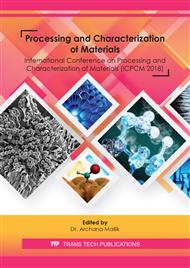p.277
p.284
p.291
p.296
p.304
p.311
p.316
p.323
p.330
Effect of Bath Concentration during Electrophoretic Deposition on the Interfacial Behaviour of Hybrid CFRP Composites
Abstract:
Carbon fibre reinforced polymer (CFRP) composites a perfect structural material due to their outstanding malleable strength, great rigidity, light mass and pronounced thermal resistance. But their inferior out-of-plane properties which are controlled by the matrix–fibre interface restrict the use of CFRP composites in critical applications. Amalgamation of nanofiller in the CFRP composites has found to improve the matrix-fibre interface and there by out-of-plane response. Though matrix modification has contributed to the improvement of interface, fibre modification has a scope for higher levels of nanofiller incorporation and proper fibre nanofiller adhesion. Out of several methods available for fibre modification electrophoretic deposition (EPD) is an eye-catching method for monitoring as well for nanofiller deposition. In recent ages, Graphene has grabbed wonderful consideration Among the graphene based functionalised nanofillers Carboxyl functionalized Graphene (G-COOH) modified CFRP composites have shown better ILSS properties. This research primarily aims to fabricate a CFRP composite using G-COOH modified carbon fibres with varying nanofiller concentrations of 0.5g/ltr, 1g/ltr and 1.5g/ltr in the EPD bath and its impact on the mechanical properties of the FRP composites. The laminates thus obtained were subjected to short beam shear test for the determination of inter laminar shear strength (ILSS). Fractography of the tested samples to observe various failure modes has been carried out by using scanning electron microscope (SEM).
Info:
Periodical:
Pages:
304-310
Citation:
Online since:
February 2020
Keywords:
Price:
Сopyright:
© 2020 Trans Tech Publications Ltd. All Rights Reserved
Share:
Citation:


